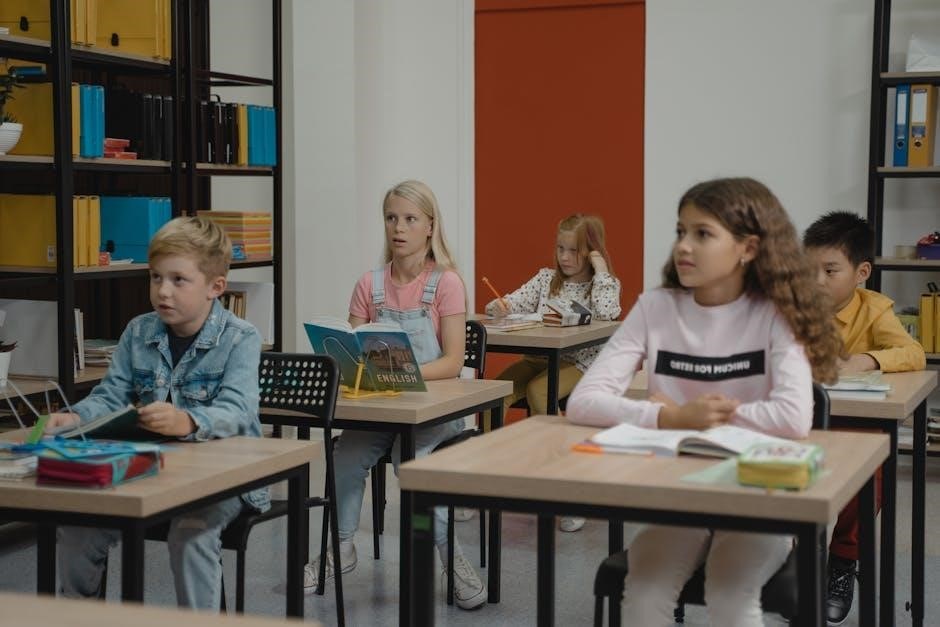Culturally responsive teaching is an approach that values diversity and promotes equity in education, using strategies to support students from diverse backgrounds effectively always online.
Definition and Importance
Culturally responsive teaching is defined as an educator’s ability to recognize and respond to students’ cultural displays of learning and meaning making. This approach is important because it values diversity and promotes equity in education. According to Zaretta Hammond, culturally responsive teaching is essential for supporting students from diverse backgrounds. It involves understanding the cultural differences that affect students’ learning and using strategies to support their academic success. By using culturally responsive teaching, educators can create a more inclusive and supportive learning environment. This approach is critical for addressing the academic achievement gap and promoting social justice in education. Culturally responsive teaching is not just a pedagogical approach, but a way of being that requires educators to be aware of their own cultural biases and to be committed to ongoing learning and self-reflection. It is a key component of equitable education.
Key Areas of Focus
Culturally responsive teaching focuses on several key areas, including student-teacher relationships, cultural awareness, and academic rigor. Educators must be aware of their own cultural biases and how they impact their teaching practices. They must also be knowledgeable about the cultural backgrounds and experiences of their students. Additionally, culturally responsive teaching emphasizes the importance of creating a safe and inclusive learning environment. This involves using strategies such as restorative practices and trauma-informed care to support students’ social and emotional needs. By focusing on these key areas, educators can create a more equitable and supportive learning environment that promotes academic success and social justice. Culturally responsive teaching requires a commitment to ongoing learning and self-reflection, as well as a willingness to adapt teaching practices to meet the diverse needs of students. This approach is essential for promoting equity in education.

Zaretta Hammond’s Approach
Zaretta Hammond’s approach focuses on brain-based teaching methods always online effectively.
Culturally Responsive Teaching and the Brain
Culturally responsive teaching is an approach that considers the brain’s function in learning, using strategies to support students from diverse backgrounds effectively. Zaretta Hammond’s work focuses on the intersection of culture and cognition, providing a framework for teachers to design instruction that is responsive to the needs of diverse learners. By understanding how the! brain processes information, teachers can create learning environments that promote equity and excellence. This approach recognizes that culture plays a significant role in shaping the brain’s development and function, and that teaching methods should be adapted to meet the needs of students from diverse cultural backgrounds. Hammond’s work has been influential in shaping the field of culturally responsive teaching, and her approach has been widely adopted by educators seeking to create more inclusive and effective learning environments, always online and accessible.
Surface Culture and Emotional Charge
Zaretta Hammond’s work identifies surface culture as a level of culture with a low emotional charge, where changes can be made without significant resistance. This level of culture includes customs, traditions, and practices that are visible and easily observable. Hammond argues that surface culture is an important aspect of culturally responsive teaching, as it provides a foundation for building relationships and establishing a positive learning environment. By recognizing and valuing students’ surface culture, teachers can create a sense of safety and belonging, which is essential for academic success. Hammond’s approach emphasizes the importance of understanding the emotional charge associated with different levels of culture, and using this knowledge to inform teaching practices and promote equity and excellence in the classroom, leading to better student outcomes and more effective teaching methods always.

Ready for Rigor Framework
Ready for Rigor framework focuses on awareness, partnership, and information processing to support culturally responsive teaching methods and strategies effectively online always.
Awareness, Partnership, and Information Processing
The Ready for Rigor framework consists of three key areas: awareness, partnership, and information processing, which are essential for culturally responsive teaching.
These areas help educators recognize and respond to the diverse needs of their students, promoting a more inclusive and effective learning environment.
The awareness component involves understanding the cultural backgrounds and experiences of students, while partnership focuses on building relationships and collaborating with students and their communities.
Information processing refers to the ways in which students process and make sense of new information, and how educators can support this process.
By focusing on these three areas, educators can create a more culturally responsive and rigorous learning environment that supports the academic success of all students.
This approach is supported by research and has been shown to be effective in improving student outcomes, particularly for students from diverse backgrounds.
The framework provides a structured approach to culturally responsive teaching, helping educators to develop the skills and knowledge needed to support their students.

Strategies for Culturally Responsive Teaching
Effective strategies for culturally responsive teaching include recognizing and valuing diversity always online with students and teachers working together effectively every day.
Recognizing Students’ Cultural Displays
Recognizing students’ cultural displays is a crucial aspect of culturally responsive teaching, as it allows educators to understand and appreciate the diverse backgrounds and experiences of their students. This involves being aware of the various ways in which students express themselves, including their language, customs, and values.
By recognizing and valuing these cultural displays, educators can create a more inclusive and supportive learning environment, where students feel comfortable and confident in expressing themselves. This, in turn, can lead to increased student engagement, motivation, and academic achievement. Effective recognition of cultural displays also requires educators to be aware of their own cultural biases and assumptions, and to be willing to learn from and adapt to the diverse needs of their students, using strategies from Zaretta Hammond’s approach to promote authentic engagement and rigor.
Responding Positively to Cultural Differences
Responding positively to cultural differences is essential in creating an inclusive learning environment, where students feel valued and respected. This involves educators being aware of their own cultural biases and assumptions, and being willing to learn from and adapt to the diverse needs of their students. By responding positively to cultural differences, educators can promote cross-cultural understanding, empathy, and communication, leading to a more harmonious and productive classroom. Effective responses to cultural differences also require educators to be flexible and open-minded, using strategies such as active listening and critical self-reflection to navigate complex cultural interactions and promote student success, as discussed in Zaretta Hammond’s approach to culturally responsive teaching. This approach helps educators to build strong relationships with their students and create a supportive learning environment.
Brain-Based Learning and Culturally Responsive Teaching
Brain-based learning combines with culturally responsive teaching to enhance student engagement and academic success always using online resources effectively every day.
Understanding Students’ Learning and Meaning Making
Understanding students’ learning and meaning making is crucial in culturally responsive teaching, as it allows educators to recognize and respond to the diverse ways students construct knowledge and make sense of the world around them. This involves being aware of the cultural, social, and emotional factors that influence students’ learning and using this awareness to inform instructional practices. By understanding how students learn and make meaning, educators can create learning environments that are inclusive, supportive, and challenging for all students. This requires a deep understanding of the complex interactions between culture, cognition, and emotion, as well as a commitment to ongoing learning and professional development. Effective educators use various strategies to understand students’ learning and meaning making, including observation, dialogue, and feedback, to create a more equitable and effective learning environment for all students to succeed.

and Resources
Culturally responsive teaching resources are available online for educators to download and implement in their classrooms effectively always.
Downloadable Resources and Further Reading
For educators seeking to deepen their understanding of culturally responsive teaching, various downloadable resources are available, including Zaretta Hammond’s ebook and pdf files. These resources provide valuable insights and practical strategies for implementing culturally responsive teaching in the classroom. The ebook, titled Culturally Responsive Teaching and the Brain, offers a comprehensive approach to teaching that values diversity and promotes equity. Additionally, online platforms and websites offer further reading materials, such as articles, blogs, and research papers, that explore the intersection of culturally responsive teaching and brain-based learning. By accessing these resources, educators can gain a deeper understanding of how to support students from diverse backgrounds and create an inclusive learning environment. With these resources, educators can develop the skills and knowledge needed to implement culturally responsive teaching effectively.
